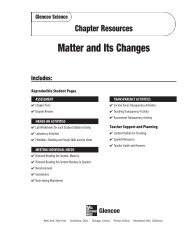Atoms, Elements, and the Periodic Table - Learning Services Home
Atoms, Elements, and the Periodic Table - Learning Services Home
Atoms, Elements, and the Periodic Table - Learning Services Home
You also want an ePaper? Increase the reach of your titles
YUMPU automatically turns print PDFs into web optimized ePapers that Google loves.
Name Date ClassCopyright © Glencoe/McGraw-Hill, a division of <strong>the</strong> McGraw-Hill Companies, Inc.2LaboratoryActivityConstructing CompoundsAll elements are made of atoms. Compounds are formed when two or more elements combineto form a different type of matter. A chemical formula is a shortcut chemists take to describe aspecific compound. It tells <strong>the</strong> numbers <strong>and</strong> types of atoms that make up a single unit of acompound. You probably already know that <strong>the</strong> formula for one common compound—water—isH 2 O. The formula for water tells us that a molecule of water has two hydrogen atoms <strong>and</strong> oneoxygen atom.StrategyYou will build models of different compounds.You will use your models to determine how many atoms of each element are in each molecule.Materialsmodeling clay (red, yellow, <strong>and</strong> blue)toothpicksProcedure1. Obtain enough clay to make four balls ofeach color. Each clay ball represents oneatom of an element. Blue balls representhydrogen atoms, red balls represent oxygenatoms, <strong>and</strong> yellow balls represent carbonatoms.2. Using toothpicks to connect your clayatoms as shown Figure 1, construct amodel of each of <strong>the</strong> following compounds.After you construct each model,fill in <strong>the</strong> blanks for that compound in <strong>the</strong>table in <strong>the</strong> Data <strong>and</strong> Observations section.After you finish making <strong>the</strong> molecules forwater <strong>and</strong> carbon dioxide, take <strong>the</strong>m apart.Then make <strong>the</strong> methane molecule.a. H 2 O (water): Connect two hydrogenatoms to one oxygen atom.b. CO 2 (carbon dioxide): Connect twooxygen atoms to one carbon atom.c. CH 4 (methane): Connect four hydrogenatoms to one carbon atom.Figure 1H<strong>and</strong>s-On Activities<strong>Atoms</strong>, <strong>Elements</strong>, <strong>and</strong> <strong>the</strong> <strong>Periodic</strong> <strong>Table</strong> 11














